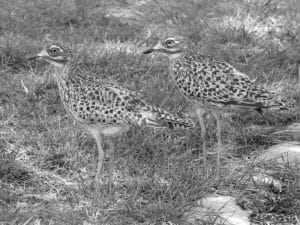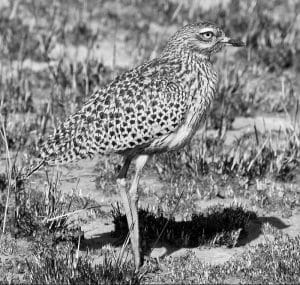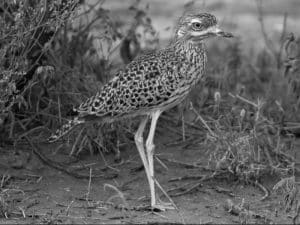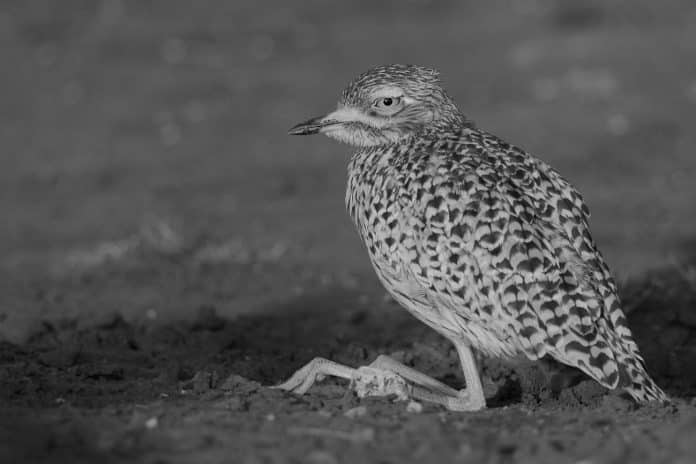Introduction to the spotted thick-knee
The spotted thick-knee, known scientifically as Burhinus capensis, is a fascinating bird species that can be found in Tanzania’s wetland areas. Also known as the spotted dikkop or the Cape thick-knee, these birds are known for their exceptional hunting skills and remarkable camouflage. This article will delve into the habitat, physical characteristics, adaptations, hunting behavior, breeding habits, conservation status, and best places to spot the spotted thick-knee in Tanzania. So, grab your binoculars and embark on a journey to discover these camouflaged hunters of the wetland shores!
Habitat and distribution of the spotted thick-knee in Tanzania

The spotted thick-knee is widely distributed across Tanzania, particularly in the wetland areas such as swamps, marshes, and coastal regions. These birds prefer habitats with a mix of tall grasses, open areas, and water bodies. They can also be found in savannas, floodplains, and even cultivated fields. Their distribution spans from the lowlands to the highlands, making Tanzania a perfect home for these remarkable birds.
Physical characteristics of the spotted thick-knee
The spotted thick-knee is a medium-sized bird, measuring around 40-50 centimeters in length. They have a distinctive appearance, with a large head, a thick neck, and a robust body. One of their most striking features is their large, yellow eyes, which are perfectly adapted for night vision. Their plumage is predominantly grayish-brown, with intricate patterns of dark spots and streaks that provide excellent camouflage against their surroundings. They also have long, yellow legs, which allow them to wade through shallow waters effortlessly.
Adaptations and hunting behavior of the spotted thick-knee
The spotted thick-knee is a master of adaptation, with several unique features that aid in its hunting behavior. Their large eyes are not only beneficial for night vision but also allow them to detect even the slightest movements of their prey. These birds primarily feed on insects, small rodents, frogs, and even small fish. They employ a sit-and-wait hunting strategy, patiently remaining motionless until their prey comes within striking distance. Once they spot their target, they swiftly pounce on it with their sharp beak, securing a meal with remarkable precision.
The hunting behavior of the spotted thick-knee is not limited to night-time. They are also active during the day, especially during the early morning and late afternoon. Their keen eyesight, combined with their exceptional camouflage, makes them expert hunters in both light and dark conditions. Their ability to blend seamlessly with their surroundings allows them to approach their prey unnoticed, giving them a significant advantage in the wetland ecosystem.
Camouflage and defense mechanisms of the spotted thick-knee

The spotted thick-knee’s camouflaged plumage is a crucial defense mechanism that helps them evade predators and remain hidden from potential threats. Their intricate patterns of spots and streaks mimic the patterns of the surrounding vegetation, making it incredibly difficult for predators to spot them. When they sense danger, they freeze and rely on their camouflage to blend seamlessly with their environment. This remarkable adaptation ensures their survival in the wetland shores, where potential threats lurk both on land and in the water.
In addition to camouflage, the spotted thick-knee also employs a few other defense mechanisms. When confronted by a predator, they may resort to distraction displays, feigning injury or acting as if their wings are broken. This behavior lures the predator away from their nest or young, giving them a chance to escape. They may also emit loud, piercing calls to alert other birds in the area of potential danger. These defense mechanisms, combined with their camouflage, make the spotted thick-knee a formidable survivor in Tanzania’s wetland ecosystems.
Breeding and nesting habits of the spotted thick-knee
Breeding season for the spotted thick-knee typically occurs during the wet season when food availability is abundant. They are monogamous birds, forming pair bonds that can last for several years. The male and female work together to build a shallow nest on the ground, usually in a concealed location among tall grasses or rocks. The female lays two eggs, which both parents take turns incubating for approximately 28 days.
Once the eggs hatch, the parents continue to share the responsibility of caring for the young chicks. The chicks are born with a fluffy down that provides insulation and helps them blend in with their surroundings. They remain in the nest for a few days before venturing out, but they are still heavily reliant on their parents for protection and food. The spotted thick-knee’s dedication to parenting ensures the survival of their offspring in the challenging wetland environment.
Conservation status and threats facing the spotted thick-knee in Tanzania
The spotted thick-knee is currently classified as a species of least concern on the IUCN Red List. However, like many other bird species, they face various threats that can impact their population numbers. Habitat loss and degradation due to agriculture, urbanization, and the conversion of wetlands to other land uses pose significant challenges for the species. Pollution, including the use of pesticides and water contamination, can also have detrimental effects on their survival.
Furthermore, disturbance from human activities such as recreational activities, tourism, and uncontrolled access to their breeding grounds can disrupt their nesting and breeding behaviors. Climate change and its associated impacts, such as altered rainfall patterns and rising temperatures, may also affect the availability of suitable habitats for the spotted thick-knee. It is crucial to raise awareness about these threats and implement effective conservation measures to ensure the long-term survival of this remarkable species.
Best places to spot the thick-knee in Tanzania
If you’re eager to catch a glimpse of the spotted thick-knee in Tanzania, there are several prime locations where you’re likely to find them. Some of the best places to spot these camouflaged hunters include the Serengeti National Park, the Ngorongoro Crater, Lake Manyara National Park, and the Rufiji River Basin. These areas offer a diverse range of wetland habitats, providing ample opportunities to observe the spotted thick-knee in its natural environment.
Tips for observing and photographing the spotted thick-knee

Observing and photographing the spotted thick-knee can be a rewarding experience for wildlife enthusiasts and photographers alike. Here are a few tips to enhance your chances of capturing these magnificent birds in action:
- Patience is key: The spotted thick-knee’s hunting behavior relies on its ability to remain motionless for extended periods. Be patient and wait for the perfect moment to witness their hunting prowess.
- Use camouflage and be still: To avoid disturbing the birds, wear clothing that blends with the environment and move slowly and quietly. This will increase your chances of getting closer to the spotted thick-knee without causing them distress.
- Study their behavior: Spend time observing the birds from a distance to understand their patterns and habits. This knowledge will enable you to anticipate their movements and capture remarkable photographs.
- Respect their space: Maintain a respectful distance from the birds and avoid getting too close to their nests or breeding areas. It is essential to prioritize their well-being and minimize any potential disturbances.
Conclusion: Appreciating the beauty and importance of the spotted thick-knee in Tanzania’s wetland ecosystems
The spotted thick-knee is a true marvel of nature, perfectly adapted to thrive in Tanzania’s wetland ecosystems. Their remarkable camouflage, hunting skills, and intricate behaviors make them a delight to observe and photograph. However, it is crucial to remember that these birds face various threats to their survival, and conservation efforts are necessary to protect their habitats and ensure their long-term existence.

































